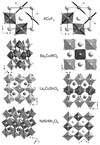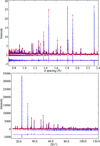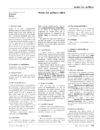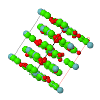issue contents
February 2004 issue

Cover illustration: Crystal packing diagram of 1,4-benzoquinone with Hirshfeld surfaces. The translucent gray surfaces illustrate the nature of these novel surfaces and how they envelop each molecule and reflect the presence of neighbouring molecules. Colours mapped on the central surface represent the distance from the surface to the nearest nucleus in an adjacent molecule: red (shortest), through green, to blue (longest) (McKinnon, Spackman & Mitchell, Acta Cryst. B, in preparation).
research papers
Download citation


Download citation


Neutron and X-ray diffraction studies indicate that at high pressure the monoclinic to trigonal phase transition in lead phosphate is accompanied by the development of static disorder of the Pb atoms. This disorder in the trigonal phase is suppressed at pressures more than 1 GPa above the transition pressure at room temperature.
Cooperative Jahn–Teller distortions and their interplay with octahedral tilting and cation ordering have been examined systematically in AMX3 perovskites containing a Jahn–Teller ion on the octahedral site, as well as in quaternary A2MM′X6 perovskites containing a Jahn–Teller ion on one-half of the octahedral sites.
An alternative superspace description of the perovskite-related compound NaCa4Nb5O17 as a commensurate modulated structure with discontinuous atomic domains is proposed. This approach highlights the layered character of the structure and can be applied to predict the space group and structure of other members of the [Na,Ca]nNbnO3n+2 compound series.
Download citation


Download citation


This paper describes the structures and thermal expansion properties of trigonal ZrMo2O8 and HfMo2O8. Both materials have been shown to undergo displacive phase transitions at high temperature to a new trigonal structure with space group P m1.
m1.
Download citation


Download citation


The crystal structure of an iron(II) spin-crossover compound, [Fe(C10H8N6)2](ClO4)2, is solved from X-ray powder diffraction data and the thermal spin transition is monitored using the change in unit-cell parameters with temperature.
Download citation


Download citation


The title ligands form hydrated complexes with Ca2+, Sr2+ and Ba2+ in which the metal–ligand coordination may give finite (zero-dimensional) entities or coordination polymers on one, two or three dimensions.
Download citation


Download citation


With a variety of carboxylic acids, 1,4,8,11-tetraazacyclotetradecane forms solvated salts that contain hydrogen-bonded supramolecular structures in two or three dimensions.
Download citation


Download citation


In symmetrically 4,6-disubstituted 2-aminopyrimidines, hard hydrogen bonds can generate supramolecular structures in zero, one, two or three dimensions.
Download citation


Download citation


A comparison of the structures of (S,S)-dileucine methyl esters with oxalamide, monothiooxalamide and dithiooxalamide bridges is presented. Asymmetric substitution of one oxygen by sulfur leads to packing of the helical hydrogen-bonded supramolecular assemblies with non-crystallographic, approximate 41 symmetry along b in the non-polar space group P212121. Molecules with chemically symmetrical bridges (oxalamide and dithiooxalamide) are packed in the polar space group P41 with similar hydrogen-bonded supramolecular assemblies.
Download citation


Download citation


2,4,6-Trimethoxy-1,3,5-triazine is found to exhibit three different polymorphs. The major difference between these polymorphs is the mode of packing of the molecules in the crystal.
Bond lengths and angles in two series of compounds with a tertiary C atom, calculated at the DFT level, conform qualitatively to the Walsh rule. In the presence of an electron-attracting substituent the angles are usually widened and bonds shortened.
Download citation


Download citation


A single-crystal X-ray structure analysis is presented for the incommensurate structure of quininium (R)-mandelate. The structure was solved in two superstructure approximations, with Z′ = 15 and Z′ = 18, and then refined in (3+1)-dimensional space using the superspace approach.
international union of crystallography
Free 



 journal menu
journal menu






























